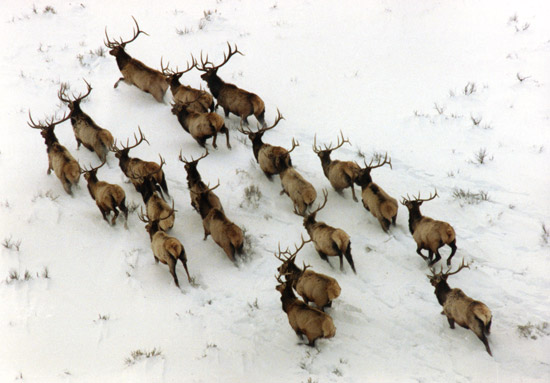What Is It?
- Echinococcus granulosus (E. granulosus) is a very small (3-5mm) tapeworm that requires two different animal species, a canid and an ungulate, to complete its lifecycle.
Why Is It Important?
- Echinicoccus granulosus can infect humans (Cystic Hydatid Disease).
- The presence of E. granulosus in wild canids and possibly domestic dogs in Idaho may allow humans to be exposed to this parasite.
Where Is It Located?
- Echinococcus granulosus is common worldwide in a domestic sheep and dog cycle.
- In some places E. granulosus occurs in wolves and wild ungulates, dingos and kangaroos, and jackels and domestic cattle.
- Global Distribution Map. - [PDF, 1.4 MB]
Who Is Affected By It?
- The adult tapeworm lives in the small intestine of a canid (dogs, wolves, coyotes, foxes).
- The larval form (hydatid) is usually found in the lungs or liver of a herbivore (deer, elk, moose, sheep, cattle).
- Humans may become infected with the larval (hydatid) stage, after ingesting eggs of this parasite.
How Does Infection Occur?
- If a canid eats a hydatid from an ungulate, the juvenile tapeworms (protoscolices) grows into an adult tapeworm in the intestine of the canid host.
- The adult tapeworm in the canid releases eggs in the feces of the canid.
- If a herbivore grazes an area that is contaminated with the tapeworm eggs, eggs that are eaten hatch into an oncospheres or larvae and migrate through blood vessels, generally to the lung or liver where it forms a hydatid cyst.
- If a human eats an egg, it can hatch into an oncospheres or larvae and form a hydatid cyst in tissue, generally the lung or liver. The cysts can vary in size (1-14 inches) and generally take years to develop.
- See Life Cycle. - [PDF, 1.4 MB]
How Do I Keep Myself, My Family, and My Pets From Becoming Affected?
- Do not harvest obviously sick or injured animals.
- Wear latex or rubber gloves when field dressing and skinning game.
- Thoroughly cook wild game meat.
- Do not touch or disturb dead animals or carnivore feces.
- Regularly deworm pet dogs.
- Do not let pet dogs eat organs or scraps from hunter harvested or road killed animals.
- Practice good hygiene - washing hands and washing contaminated clothes, especially after handling animals or feces.
What Is Idaho Fish and Game Doing to Help Manage This Disease?
- Since 1998, Idaho Fish and Game has conducted disease surveillance in wildlife including ungulates and wolves. No evidence of this tapeworm, eggs, or larva was discovered until 2006.
- In 2006, hydatid cysts were found in the lungs of a mountain goat from Atlanta, ID. The adult tapeworm was also first found in the intestines of wolves in 2006.
- During intensive surveillance between 2006 - 2010, hydatid cysts were found in the lungs of numerous deer and elk from central Idaho; and 62% of wolves tested were determined to be infected with the tapeworm.
- We are continuing its surveillance and investigations of this parasite.
- We provide public education about this parasite.
- We coordinate with Idaho State Department of Agriculture and the Idaho Department of Health and Welfare to provide information about this parasite to veterinarians, physicians and health care workers.

For More Information:
- Echinococcus: Focus on Idaho - Idaho Health & Welfare Disease Bulletin, April 2010
- Echinococcus granulosus Q&A - Idaho Fish and Game
- Echinococcus granulosus in Wolves in Idaho - [PDF, 142 KB]
- Parasites and Health - Centers for Disease Control and Prevention
- Disease Precautions for Hunters - American Veterinary Medical Association
- Echinococcosis - Michigan Dept of Natural Resources and Environment
- Echinococcus granulosus History, Info - Stanford University
- Echinococcosis - From Wikipedia
Last Updated: August 19, 2015
Top of page
Top of page
